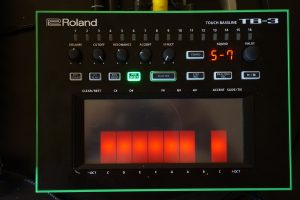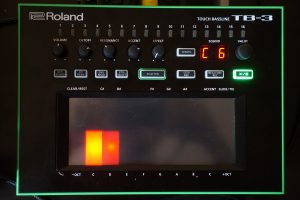 Let’s see if I can re-create this drum pattern, TNGHT’s “Higher Ground,” using the Blofeld’s onboard arpeggiators. It’s not going to be easy, but I’m sure it’s possible, and probably in more than one way. First thing I did was listen to the original track in super slo-mo and mapped out the basic pattern of kick, snare, & clap and put them into a 16th note grid. There is also a hi-hat, a few different snare patterns and rolls, a vocal sample and a lead that I’ll need to add, but I’ll start with the basic stuff.
Let’s see if I can re-create this drum pattern, TNGHT’s “Higher Ground,” using the Blofeld’s onboard arpeggiators. It’s not going to be easy, but I’m sure it’s possible, and probably in more than one way. First thing I did was listen to the original track in super slo-mo and mapped out the basic pattern of kick, snare, & clap and put them into a 16th note grid. There is also a hi-hat, a few different snare patterns and rolls, a vocal sample and a lead that I’ll need to add, but I’ll start with the basic stuff.
The kick pattern above sounds like a big 808 kick drum with a long decay and is on a 16th note pattern, but in the last measure, there is a high version of the kick that lands between the beats. It sounds like a triplet to me, so somehow I’ll need to make a kick pattern that has both a regular beat and then a triplet beat at the end. I had already made some of the other parts, the snares, the claps, and one of the snare rolls, along with the sample, but I still couldn’t get that last kick measure right, pitched up an octave and syncopated against the beat, presumably with a triplet pattern.
My first effort was to just make a triplet beat to see if it sounded right. So to  make sure I set up a 4/4 kick and then laid a 1/8T beat, no user pattern, with a hihat sound over it. Yes, that worked. Then to try and make the beats land properly according to the grid, I made the 1/8T beat a 12 step user pattern like in the photo and it seemed to work well, coming around when it should against the 4/4 beat, so, I thought, just change the sound for this arp pattern to a kick, and try to lay a straight beat over it for the other sounds. Well, that didn’t work because the kick would come around too soon, essentially it’s in 3/4 and everything else is in 4/4 so I couldn’t get everything in the proper time.
make sure I set up a 4/4 kick and then laid a 1/8T beat, no user pattern, with a hihat sound over it. Yes, that worked. Then to try and make the beats land properly according to the grid, I made the 1/8T beat a 12 step user pattern like in the photo and it seemed to work well, coming around when it should against the 4/4 beat, so, I thought, just change the sound for this arp pattern to a kick, and try to lay a straight beat over it for the other sounds. Well, that didn’t work because the kick would come around too soon, essentially it’s in 3/4 and everything else is in 4/4 so I couldn’t get everything in the proper time.
Then I hit on it…I could just trigger the last two notes as a separate arp at the end of the measure. So I set up a copy of the original kick pattern with arp set to 1/8T…and it didn’t quite sound right. Then I changed to 1/8., or a dotted eight note and it sounded I thought exactly correct. Turns out it probably wasn’t a eight note triplet, it was a dotted eighth note. I left the last measure of the original kick pattern blank and trigger this 1/8. pattern for one measure at the end. It may be possible to latch the high triplet kick pattern so that it syncs with the other main kick pattern, but the closest I got was setting clock to 1/4T, note length 1/16, pattern length 12, with notes triggered on step 11 & 12, but that’s not quiiite right, although it’s close. Gotta keep working on it!






